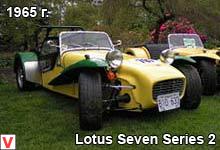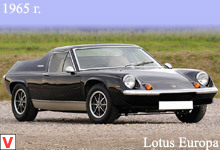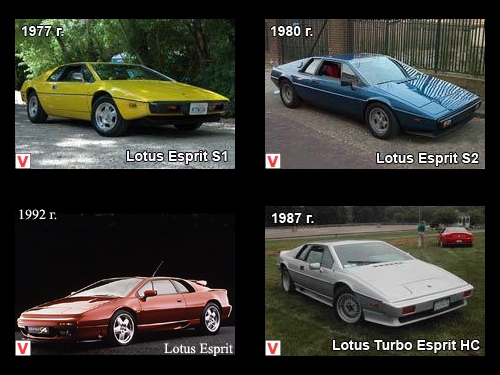
The Lotus Esprit is a sports car in a 2-door coupe that was produced by a British car company in the UK from 1976 to 2004. The debut of this model took place at the Turin Auto Show in 1972, at which it was presented as a concept car from the design bureau Italdesign-Giugiaro, built on the basis of a shortened chassis from Lotus Europa. It was the first project of the Italian designer Giorgetto Giugiaro (Giorgetto Giugiaro) created in the era of polygonal (modeling using polygons - polygons) "chopped" design, which in English-speaking countries was called "folded paper" - "folded paper".
Before going into mass production, the Lotus Esprit car in its final version was presented at the Paris auto show in October 1975, and the launch of this sports car started in June 1976. In the model range of Lotus Cars, the Lotus Esprit car took the place of the previously produced Lotus Europa model. The first Esprit cars wore the S1 (Series 1) marking.

Built on a chassis frame and in the back of a fiberglass, the Esprit was equipped with a four-cylinder Lotus 907 engine that was previously used in a Jensen Healey automobile. This power unit of 2 liters gave a power equal to 160 hp (in cars intended for export power was 140 hp) and was located longitudinally directly behind the passengers, like the predecessor. The transmission in the transmission unit was 5-speed and was previously used in cars like the Citroen SM and Maserati Merak. The first series, entirely made on the principles of light weight of the company Lotus, had a mass of less than 1000 kg.
The sports car gained its popularity due to the appearance in 1977 of the James Bond movie “The Spy Who Loved Me”. In this film, the Esprit model participated in the chase and could turn into a submarine. Many in those days praised the sports car Lotus Esprit for its handling. However, it was rated as not powerful enough, especially in markets such as the USA, where this model was supplied with reduced power characteristics in order to reduce exhaust. Lotus wanted to achieve speeds such as acceleration to 100 km / h in 6.8 seconds, and its maximum speed of 222 km / h, but they were very optimistic.
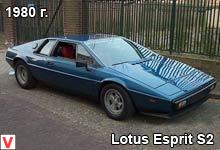
Real road tests showed something completely different - from zero to 100 km / h in 8 seconds, and the maximum speed - 214 km / h. The Esprit of the first series could be distinguished from the later versions by the scoop-shaped front spoiler, rear lights from the Fiat X1 / 9, the absence of air intake tunnels on the sides and the cast wheels of the Wolfrace. A number of improvements to the sports car Lotus Esprit led to a climax in its history - the release of the second series of S2 (2 Series).
The most obvious of these changes are: the emergence of air intake tunnels located on the sides of the car behind the rear side windows, taillights from the Rover SD1 and an integrated front spoiler. Also, Esprit cars of the second series were equipped, specially developed by Lotus, with 14-inch alloy wheels «Speedline». Of the other changes, it is worth noting the change in the location of the battery, improved access to the engine, as well as the replacement of the dashboard from Veglia, a new one from Smith, and a new design of the switches. In the era of the second generation of the Esprit model, its special version was developed in honor of the sports victories of the Lotus company.
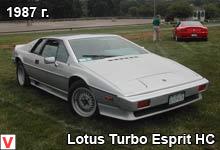
It was painted in black and gold colors, like the Formula 1 race cars in the Lotus team sponsored by John Player & Sons. The name of the special version of Esprit was also associated with the team sponsor - John Player Special (JPS) Esprit. Lotus did not provide accurate data, but approximately 149 copies of JPS Esprit were collected. In 1980, the final version of the second generation Esprit was released under the name S2.2. It was almost identical to the standard Esprit model of the second series, but it was equipped with a 2.2-liter Lotus 912 engine (volume and served this version name).
The power of the power unit was the same as that of the two-liter fellow, but the maximum torque was increased from 190 Nm to 217 Nm. Note also that in version S2.2 was presented the chassis, made of galvanized steel. A total of 88 Esprit S2.2 cars were produced. In 1980, the first turbo version of the Lotus Esprit was also introduced. Initially, it was another special version associated with the participation of Lotus in Formula 1 racing and was painted in blue, red in combination with chrome elements, which corresponded to the next sponsor of the team - Essex Petroleum. The name of the new version was assigned accordingly - “Essex Esprit”.
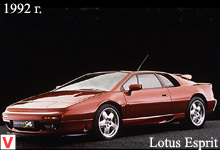
The new turbocharged Lotus 910 engine with a dry sump lubrication system developed a power of 210 hp. and maximum torque - 270 Nm. Up to 100 km / h, the Essex version could accelerate in 5.6 seconds, and the maximum speed was 240 km / h.
As a result of improved power and dynamic performance, Esprit Essex had to modernize and strengthen the chassis and rear suspension design. A central thrust has been added in order to reduce the load on the propeller shaft, and the vehicle's braking system has been improved. Especially for Essex, Giugiaro developed an aerodynamic body kit that included a rear spoiler, updated bumpers, additional ventilation tunnels on the sides in front of the rear wheels.
Also this version received 15-inch rims from the company Compomotive. The interior was made in scarlet leather and equipped with a Panasonic stereo. A total of 45 copies of Essex Esprit were collected. This version, painted in a copper-red color, also took part in the filming of the next James Bond movie called “For Your Eyes Only”, which was introduced in 1981. By the end of 1980, Lotus introduced three different versions of the Esprit model with various chassis structures and body elements: Domestic S2.2 (weight for the UK), Export S2.2 (export version), and Turbo Esprit with a system dry sump lubrication.
The Turbo Esprit and Esprit versions of the third S3 Series (Series 3), introduced into production in April 1981, were somewhat consolidated: they had a common chassis structure, inheriting most of its structure from the Essex version, and also had a common body kit. The Lotus Esprit model of the third series used the same Lotus 910 engine with a 2.2-liter capacity as in the “S2.2” version, while the “Turbo Esprit” returned to a less complex lubrication system with a conventional oil sump. Indicators of power and maximum torque were the same as that of the old dry sump power pack.
The interior of both versions has been completely redesigned to reflect the modified body forms, which increased the space above the passengers' head and the niche for the legs. As for the exterior, the version of “Turbo Esprit” retained all the elements of the aerodynamic package from “Essex Esprit”, and also added stickers with the words “turbo esprit” on the front and side parts; S3 version has received new bumpers, but still the rest of the body shape remained from modification S2.2. In April 1986, the latest “Esprit” was introduced under the guidance of designer Giugiaro, with increased engine compression, which was the name of “HC” (High Compression).
The increase in compression allowed to increase the characteristics of the engine without supercharging - power of 172 hp, and maximum torque of 220 Nm. The turbo version of the Turbo Esprit HC delivered a power of 215 hp and a maximum torque of 300 Nm. For markets with stringent exhaust emission requirements, Lotus produced a modification of the “HCi”, whose engine was fitted with a KE-Jetronic fuel injector from Bosh.
It is worth noting that it was the first Esprit with an injection engine. In 1988, a new version of Lotus Esprit was released, developed by the English designer Peter Stevens (by that time such famous sports cars as Jaguar XJR-15 and McLaren F1 had already been created under his leadership). This time, the taillights were borrowed from the Toyota Corolla Coupe.
Giorgetto Giugiaro liked Esprit restyling, but he claimed that he was still too much like his original design. As for the technical equipment of the version from Stevens, it was almost completely identical to that used in previous versions, and also turbocharged and atmospheric engines were available. However, there were some differences: more reliable gearbox in the block with the transmission of production Renault and the new system of electronic fuel injection Delco GMP4 EFI. External changes were accompanied by an update of the interior. The Esprit Stevens version was also known as the “X180”.
Model Stevens Esprit in 1988 was only twice seen in a television series called “The Highwayman” (so briefly participating in the series was the fact that his show was stopped after the filming of the 10th series). The next improvement in the Esprit model was that, in addition to water cooling, it was equipped with a charge air cooler. This modification has been labeled "SE". The power of the Esprit SE increased to 264 hp, and in a complete set with an atmospheric turbo engine to 280 hp. From zero to 100 km / h, this version accelerated in 4.7 seconds, and its maximum speed was 260 km / h The Lotus 910 engine with a charge air cooler is labeled “S”.
Also, modifications were noted in the body kit sports car. The Lotus Esprit is still a little behind competing sports cars of brands such as Porsche and Ferrari. The Lotus Esprit was popular and quite successfully performed at the American sports car competition “IMSA Bridgestone Supercar Championship”, as a result of which Lotus decided to release another version based on the SE modification called X180R, with a power increased to 300 hp. and racing equipment salon. The modification known as Sport 300 was essentially the same X160R intended for the European market.
The Esprit Sport 300 was recognized as the fastest 4-cylinder car in the Esprit line and the most anticipated. In 1993, the updated exterior and interior of the Lotus Esprit sports car marked the release of the fourth generation of this model, the S4 (Series 4). Note that this was the first version of the Esprit, which was equipped with a power steering. In 1995, this series was supplemented with a modification «S4s», whose power was 300 hp at the same time, it had a comfortable cabin, like the one in the S4. This car was supposed to be the completion of the production of the Esprit model, but in the end it was decided to equip the sports car with a new compact V8 engine.
In 1996, a new version was introduced under the name Esprit V8, which was equipped with a Lotus 918 engine of 3.5 liters with a twin turbine. It used all the same gearbox in the block with the transmission from the company Renault. Engineer Derek Bell (Derek Bell) worked on finalizing the gearbox so that she could withstand 355 hp engine power. (Renault standard transmission quickly broke down). Acceleration from standstill to 100 km / h on the Esprit V8 took less than 5 seconds. Along with the “Esprit V8”, the GT3 version was also introduced, which was equipped with a two-liter turbocharged engine with a charge air cooler, which was previously common in Italian sports cars.
In 1998, the V8 version was divided into two versions: “SE” and “GT”. Both configurations had a modified trim, among which the SE version had a more luxurious interior. The final modification of the Lotus Esprit model was introduced in 1999 and was called the Sport 350. A total of 50 copies of the vehicle of this configuration were collected.
Each of them gave out power equal to 350 hp (in accordance with the name) and was built on different chassis, as well as with various improvements to the brake system. Acceleration to 100 km / h in this version took less than 5 seconds, and the mass did not exceed 1300 kg, thanks to a body made of fiberglass. Production of the sports car Lotus Esprit continued until 2004. During this time, the car changed only slightly, of the changes, perhaps, it is worth noting the appearance of four round rear lights in 2002.
Over 28 years of production, 10,675 Lotus Esprit cars were assembled. According to various sources, it is known that during the production of the Lotus Esprit model, as in many cases with such cars, the company's engineers used various parts of the technical equipment from cars of other brands. For example, in the Esprit sports cars, produced before 1993, there were a lot of elements manufactured by Leyland, and for those that were produced after 1993, various technical components were borrowed from General Motors (Vauxhall, Opel). Lotus is currently developing a new-generation Esprit model, as evidenced by numerous spy photos and materials in various automotive publications.
It was supposed that it will be presented already in 2008, but according to the latest data, according to the company's plans, it is assumed that the actual release date will be December 2009.
